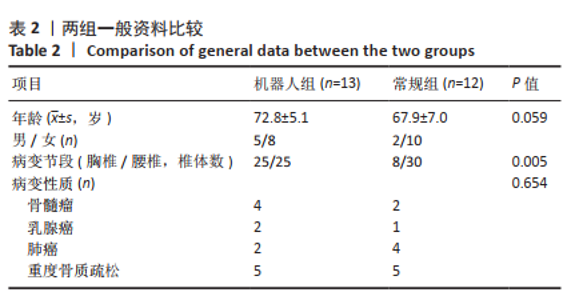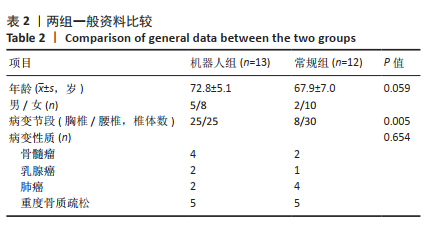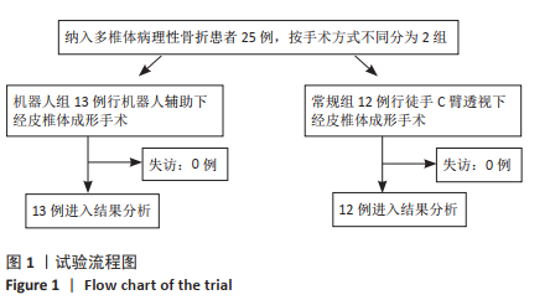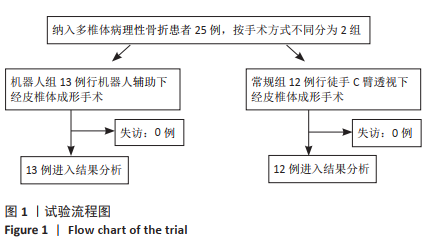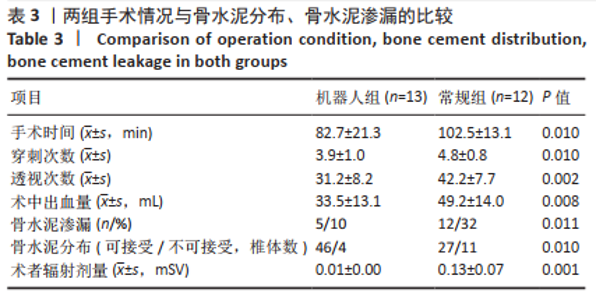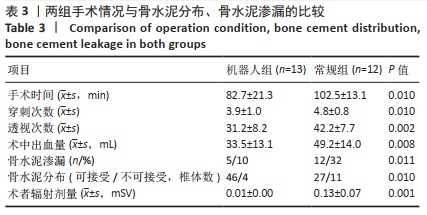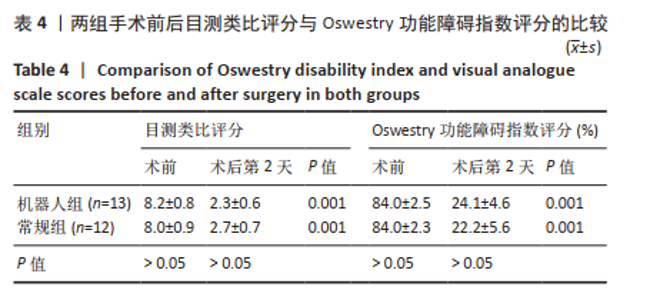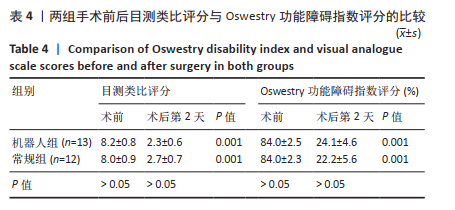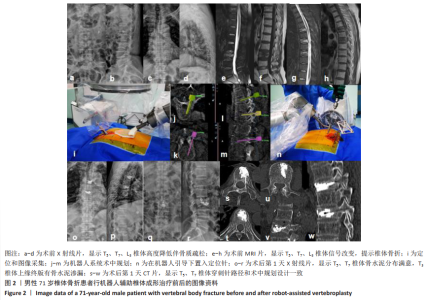Chinese Journal of Tissue Engineering Research ›› 2022, Vol. 26 ›› Issue (16): 2467-2472.doi: 10.12307/2022.242
Previous Articles Next Articles
Robot-assisted percutaneous vertebroplasty in the treatment of pathological fractures of thoracolumbar multivertebra
Yu Yang, Tang Liuyi, Hu Jiang, Wan Lun, Zhang Wei, Lin Shu, Wang Fei
- Department of Orthopedics, Affiliated Hospital of University of Electronic Science and Technology, Sichuan Provincial People’s Hospital, Chengdu 610072, Sichuan Province, China
-
Received:2020-09-02Revised:2020-09-04Accepted:2020-10-24Online:2022-06-08Published:2021-10-29 -
Contact:Hu Jiang, Master, Chief physician, Department of Orthopedics, Affiliated Hospital of University of Electronic Science and Technology, Sichuan Provincial People’s Hospital, Chengdu 610072, Sichuan Province, China -
About author:Yu Yang, Master, Associate chief physician, Department of Orthopedics, Affiliated Hospital of University of Electronic Science and Technology, Sichuan Provincial People’s Hospital, Chengdu 610072, Sichuan Province, China -
Supported by:the Science and Technology Support Project of Sichuan Science and Technology Department, No. 2019YFS0268 (to HJ)
CLC Number:
Cite this article
Yu Yang, Tang Liuyi, Hu Jiang, Wan Lun, Zhang Wei, Lin Shu, Wang Fei. Robot-assisted percutaneous vertebroplasty in the treatment of pathological fractures of thoracolumbar multivertebra[J]. Chinese Journal of Tissue Engineering Research, 2022, 26(16): 2467-2472.
share this article
Add to citation manager EndNote|Reference Manager|ProCite|BibTeX|RefWorks
| [1] ALEXANDRU D, SO W. Evaluation and management of vertebral compression fractures. Perm J. 2012;16(4):46-51. [2] SI L, WINZENBERG TM, JIANG Q, et al. Projection of osteoporosis-related fractures and costs in China: 2010-2050. Osteoporosis Int. 2015;26(7):1929-1937. [3] FERLAY J, SOERJOMATARAM I, DIKSHIT R, et al. Cancer incidence and mortality worldwide: sources,methods and major patterns in GLOBOCAN 2012. Int J Cancer. 2015;136(5):E359-E386. [4] BILSKY MH, LIS E, RAIZER J, et al. The diagnosis and treatment of metastatic spinal tumor. Oncologist. 1999;4(6):459-469. [5] MACEDO F, LADEIRA K, PINHO F, et al. Bone metastases: an overview. Oncol Rev. 2017;11(1):321. [6] GALIBERT P, DERAMOND H, ROSAT P, et al. Preliminary note on the treatment of vertebral angioma by percutaneous acrylic vertebroplasty. Neurochirurgie. 1987;33(2):166-168. [7] LIU J, TANG J, ZHANG Y, et al. Percutaneous vertebral augmentation for osteoporotic vertebral compression fracture in the midthoracic vertebrae (T5-8): A retrospective study of 101 patients with 111 fractured segments. World Neurosurg. 2019;122:e1381-e1387. [8] RAJAH G, ALTSHULER D, SADIQ O, et al. Predictors of delayed failure of structural kyphoplasty for pathological compression fractures in cancer patients. J Neurosurg Spine. 2015;23(2):228-232. [9] GERMANEAU A, VENDEUVRE T, SAGET M, et al. A novel approach for biomechanical spine analysis: Mechanical response of vertebral bone augmentation by kyphoplasty to stabilise thoracolumbar burst fractures. J Mech Behav Biomed Mater. 2016;59:291-303. [10] HUSKISSON EC. Measurement of pain. Lancet. 1974;2(7889): 1127-1131. [11] YOUNG WF, BROWN D, KENDLER A, et al. Delayed post-traumatic osteonecrosis of a vertebralbody(Kummell’s disease). Acta Orthop Belg. 2002;68(1):13-19. [12] SCHACHAR NS. An update on the nonoperative treatment of patients with metastatic bone disease. Clin Orthop Relat Res. 2001;1(382): 75-81. [13] SHIMONY JS, GILULA LA, ZELLER AJ, et al. Percutaneous vertebroplasty for malignant compression fractures with epidural involvement. Radiology. 2004;232(3):846-853. [14] BATES T. A review of local radiotherapy in the treatment of bone metastases and cord compression. Int J Radiat Oncol Biol Phys. 1992; 23(1):217-221. [15] JANDAGHI SH, ABDOLHOSEINPOUR H, GHOFRANIHA A, et al. A limb-saving procedure for treatment of arterial cement embolism during lumbar percutaneous vertebroplasty: A case report. J Tehran Heart Cent. 2013;8(1):61-64. [16] JENSEN A. Incidence of bone metastases and skeletal-related events in breast cancer patients: A population based cohort study in Denmark. BMC Cancer. 2011;24(11):29. [17] KALOOSTIAN PE, YURTER A, ETAME AB, et al. Palliative strategies for the management of primary and metastatic spinal tumors. Cancer Control. 2014;21(2):140-143. [18] ALVAREZ L, PEREZ-HIGUERAS A, QUINONES D, et al. Vertebroplasty in the treatment of vertebral tumors: postprocedural outcome and quality of life. Eur Spine J. 2003;12(4):356-360. [19] LIM BS, CHANG UK, YOUN SM. Clinical outcomes after percutaneous vertebroplasty for pathologic compression fractures in osteolytic metastatic spinal disease. J Korean Neurosurg Soc. 2009;45(6):369-374. [20] BHATT AD, SCHULER JC, BOAKYE M, et al. Current and emerging concepts in non-invasive and minimally invasive management of spine metastasis. Cancer Treat Rev. 2013;39(2):142-152. [21] CHI JH, GOKASLAN ZL. Vertebroplasty and kyphoplasty for spinal metastases. Curr Opin Support Palliat Care. 2008;2(1):9-13. [22] CHEN KY, MA HI, CHIANG YH. Percutaneous transpedicular vertebroplasty with polymethyl methacrylate for pathological fracture of the spine. J Clin Neurosci. 2009;16(10):1300-1304. [23] Oflfluoglu O. Minimally invasive management of spinal metastases. Orthop Clin North Am. 2009;40(1):155-168. [24] PFLFLUGMACHER R, BETH P, SCHROEDER RJ, et al. Balloon kyphoplasty for the treatment of pathological fractures in the thoracic and lumbar spine caused by metastasis: One-year follow-up. Acta Radiol. 2007; 48(1):89-95. [25] KOSE KC, CEBESOY O, AKAN B, et al. Functional results of vertebral augmentation techniques in patho logical vertebral fractures of myelomatous patients. J Natl Med Assoc. 2006;98(10):1654-1658. [26] QIAN Z, SUN Z, YANG H, et al. Kyphoplasty for the treatment of malignant vertebral compression fractures caused by metastases. J Clin Neurosci. 2011;18(6):763-767. [27] BARR JD, BARR MS, LEMLEY TJ, et al. Percutaneous verteb roplasty for pain relief and spinal stabilization. Spine (Phila Pa 1976). 2000; 25(8):923-928. [28] ZOARSKI GH, STALLMEYER MJ, OBUCHOWSKI A. Percutaneous vertebrop lasty: A to Z. Tech Vasc Interv Radiol. 2002;5(4):223-238. [29] SUN H, YANG Z, XU Y, et al. Safety of percutaneous vertebroplasty for the treatment of metastatic spinal tumors in patients with posterior wall defects. Eur Spine J. 2015;24(8):1768-1777. [30] 王方永,李建军.胸腰椎椎弓根解剖参数三维分析[J].中国康复理论与实践,2012,18(2):134-136. [31] MASTRANGELO G, FEDELI U, FADDA E, et al. Increased cancer risk among surgeons in an orthopaedic hospital.Occup Med (Lond). 2005; 55(6):498-500. [32] SINGER G. Occupational radiation exposure to the surgeon.J Am Acad Orthop. 2005;13(1):69-76. [33] HARSTALL R, HEINI PF, MINI RL, et al. Radiation exposure to the surgeon during flfluoroscopically assisted percutaneous vertebroplasty:a prospective study. Spine(Phila Pa 1976). 2005;30(16):1893-1898. [34] IZADPANAH K, KONRAD G, SUDKAMP NP, et al. Computer navigation in balloon kyphoplasty reduces the intraoperative radiation exposure. Spine(Phila Pa 1976). 2009;34(12):1325-1329. [35] SHAH J, VYAS A, VYAS D. The History of Robotics in Surgical Specialties. Am J Robot Surg. 2014;1(1):12-20. [36] 王嵘,赵继宗,王德江,等.导航下显微神经外科手术影像漂移的分析[J].北京医学,2002,24(3):155-157. [37] AUSTIN MS, VACCARO AR, BRISLIN B, et al. Image-guided spine surgery: a cadaver study comparing conventional open laminoforaminotomy and two image-guided techniques for pedicle screw placement in posterolateral fusion and nonfusion models. Spine (Phila Pa 1976). 2002;27(22):2503-2508. [38] RICHTER M, AMIOT LP, NELLER S, et al. Computer-assisted surgery in posterior instrumentation of the cervical spine: an in-vitro feasibility study. Eur Spine J. 2000;9 Suppl 1(Suppl 1):S65-70. [39] 田伟,刘亚军,刘波,等.计算机导航在脊柱外科手术应用实验和临床 研究[J].中华骨科杂志,2006,26(10):671-675. [40] 杨立江,陈华江,陈德玉,等.计算机辅助导航技术在脊柱侧凸手术中应用的初步经验[J].中国矫形外科杂志,2007,15(23):1173-1176. [41] BARZILAY Y, SCHROEDER JE, HILLER N, et al. Robot-assisted Vertebral Body Augmentation: A Radiation Reduction Tool. Spine(Phila Pa 1976). 2014;39(2):153-157. |
| [1] | Yao Xiaoling, Peng Jiancheng, Xu Yuerong, Yang Zhidong, Zhang Shuncong. Variable-angle zero-notch anterior interbody fusion system in the treatment of cervical spondylotic myelopathy: 30-month follow-up [J]. Chinese Journal of Tissue Engineering Research, 2022, 26(9): 1377-1382. |
| [2] | Jiang Huanchang, Zhang Zhaofei, Liang De, Jiang Xiaobing, Yang Xiaodong, Liu Zhixiang. Comparison of advantages between unilateral multidirectional curved and straight vertebroplasty in the treatment of thoracolumbar osteoporotic vertebral compression fracture [J]. Chinese Journal of Tissue Engineering Research, 2022, 26(9): 1407-1411. |
| [3] | Yu Chengxiang, Liu Lehong, Li Wenbo, Chen Jinshi, Ran Chunlei, Wang Zhongping. Correlation between spine-pelvic sagittal parameters and prognosis of vertebroplasty in the treatment of thoracolumbar osteoporotic vertebral compression fractures [J]. Chinese Journal of Tissue Engineering Research, 2022, 26(9): 1412-1417. |
| [4] | Xue Yadong, Zhou Xinshe, Pei Lijia, Meng Fanyu, Li Jian, Wang Jinzi . Reconstruction of Paprosky III type acetabular defect by autogenous iliac bone block combined with titanium plate: providing a strong initial fixation for the prosthesis [J]. Chinese Journal of Tissue Engineering Research, 2022, 26(9): 1424-1428. |
| [5] | Li Canhui, Wu Zhengjie, Zeng Yanhui, He Yinghao, Situ Xiaopeng, Du Xuelian, Hong Shi, He Jiaxiong. Advantage and disadvantage of robot-assisted sacroiliac screw placement and traditional fluoroscopy in orthopedic surgery [J]. Chinese Journal of Tissue Engineering Research, 2022, 26(9): 1434-1438. |
| [6] | Li Wei, Zhu Hanmin, Wang Xin, Gao Xue, Cui Jing, Liu Yuxin, Huang Shuming. Effect of Zuogui Wan on bone morphogenetic protein 2 signaling pathway in ovariectomized osteoporosis mice [J]. Chinese Journal of Tissue Engineering Research, 2022, 26(8): 1173-1179. |
| [7] | Wang Jing, Xiong Shan, Cao Jin, Feng Linwei, Wang Xin. Role and mechanism of interleukin-3 in bone metabolism [J]. Chinese Journal of Tissue Engineering Research, 2022, 26(8): 1260-1265. |
| [8] | Xiao Hao, Liu Jing, Zhou Jun. Research progress of pulsed electromagnetic field in the treatment of postmenopausal osteoporosis [J]. Chinese Journal of Tissue Engineering Research, 2022, 26(8): 1266-1271. |
| [9] | Wu Bingshuang, Wang Zhi, Tang Yi, Tang Xiaoyu, Li Qi. Anterior cruciate ligament reconstruction: from enthesis to tendon-to-bone healing [J]. Chinese Journal of Tissue Engineering Research, 2022, 26(8): 1293-1298. |
| [10] | Fang Xiaolei, Leng Jun, Zhang Chen, Liu Huimin, Guo Wen. Systematic evaluation of different therapeutic effects of mesenchymal stem cell transplantation in the treatment of ischemic stroke [J]. Chinese Journal of Tissue Engineering Research, 2022, 26(7): 1085-1092. |
| [11] | Wu Weiyue, Guo Xiaodong, Bao Chongyun. Application of engineered exosomes in bone repair and regeneration [J]. Chinese Journal of Tissue Engineering Research, 2022, 26(7): 1102-1106. |
| [12] | Zhou Hongqin, Wu Dandan, Yang Kun, Liu Qi. Exosomes that deliver specific miRNAs can regulate osteogenesis and promote angiogenesis [J]. Chinese Journal of Tissue Engineering Research, 2022, 26(7): 1107-1112. |
| [13] | Hu Wei, Xie Xingqi, Tu Guanjun. Exosomes derived from bone marrow mesenchymal stem cells improve the integrity of the blood-spinal cord barrier after spinal cord injury [J]. Chinese Journal of Tissue Engineering Research, 2022, 26(7): 992-998. |
| [14] | Gao Yujin, Peng Shuanglin, Ma Zhichao, Lu Shi, Cao Huayue, Wang Lang, Xiao Jingang. Osteogenic ability of adipose stem cells in diabetic osteoporosis mice [J]. Chinese Journal of Tissue Engineering Research, 2022, 26(7): 999-1004. |
| [15] | Hou Jingying, Guo Tianzhu, Yu Menglei, Long Huibao, Wu Hao. Hypoxia preconditioning targets and downregulates miR-195 and promotes bone marrow mesenchymal stem cell survival and pro-angiogenic potential by activating MALAT1 [J]. Chinese Journal of Tissue Engineering Research, 2022, 26(7): 1005-1011. |
| Viewed | ||||||
|
Full text |
|
|||||
|
Abstract |
|
|||||
